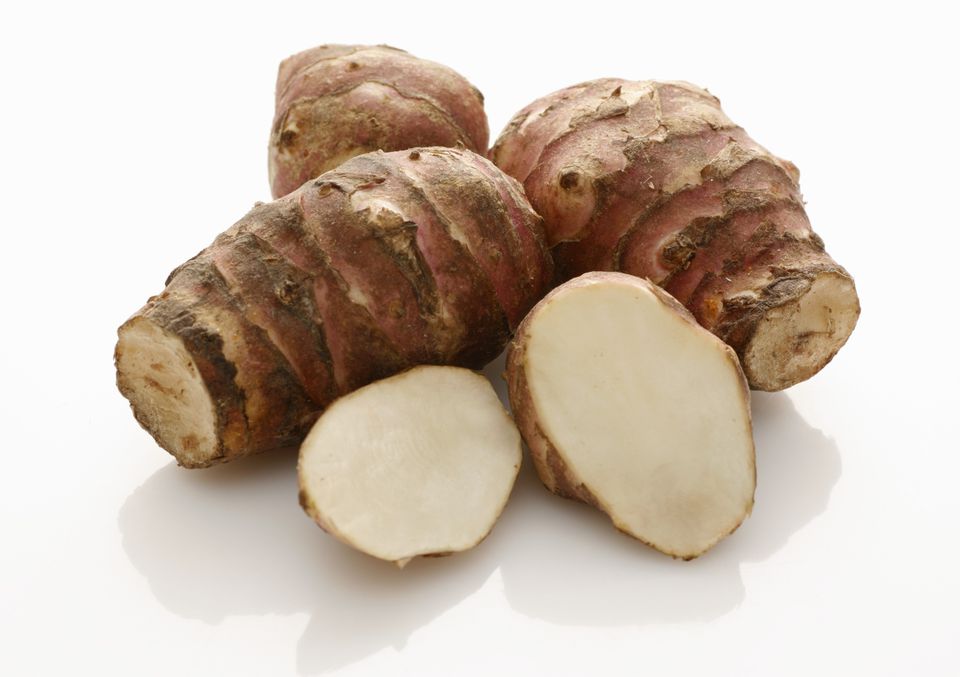
Jerusalem Artichoke (Sunchoke)
The Jerusalem artichoke, also called sunroot, sunchoke, earth apple, or topinambour, is a species of sunflower native to eastern North America, and found from eastern Canada and Maine west to North Dakota, and south to northern Florida and Texas. It is also cultivated widely across the temperate zone for its tuber, which is used as a root vegetable.Despite one of its names, the Jerusalem artichoke has no relationship to Jerusalem, and it is not a type of artichoke, though the two are distantly related as members of the daisy family. The origin of the "Jerusalem" part of the name is uncertain. Italian settlers in the United States called the plant girasole, the Italian word for sunflower, because of its familial relationship to the garden sunflower (both plants are members of the genus Helianthus).
Description
Helianthus tuberosus is a herbaceous perennial plant growing to 1.5–3 m (4 ft 11 in–9 ft 10 in) tall with opposite leaves on the upper part of the stem but alternate below. The leaves have a rough, hairy texture. Larger leaves on the lower stem are broad ovoid-acute and can be up to 30 cm (12 in) long. Leaves higher on the stem are smaller and narrower. The flowers are yellow and produced in capitate flowerheads, which are 5–10 cm (2.0–3.9 in) in diameter, with 10–20 ray florets and 60 or more small disc florets. The tubers are elongated and uneven, typically 7.5–10 cm (3.0–3.9 in) long and 3–5 cm (1.2–2.0 in) thick, and vaguely resembling ginger root in appearance, with a crisp texture when raw. They vary in colour from pale brown to white, red, or purple.
History
Jerusalem artichokes were first cultivated by the Native Americans long before the arrival of the Europeans; this extensive cultivation obscures the exact native range of the species. The French explorer Samuel de Champlain discovered that the Native people of Nauset Harbor in Massachusetts had cultivated roots that tasted like artichoke. The following year, Champlain returned to the same area to discover that the roots had a flavour similar to chard and was responsible for bringing the plant back to France. Some time later, Petrus Hondius, a Dutch botanist planted a shrivelled
Jerusalem artichoke tuber in his garden at Terneuzen and was surprised to see the plant proliferate. Jerusalem artichokes are so well suited for the European climate and soil that the plant multiplies quickly. By the mid-1600s, the Jerusalem artichoke had become a very common vegetable for human consumption in Europe and the Americas and was also used for livestock feed in Europe and colonial America. The French in particular were especially fond of the vegetable, which reached its peak popularity at the turn of the 19th century. The Jerusalem artichoke was titled 'best soup vegetable' in the 2002 Nice Festival for the Heritage of the French Cuisine.
The French explorer and Acadia’s first historian, Marc Lescarbot, described Jerusalem artichokes as being “as big as turnips or truffles”, suitable for eating and taste "like chards, but more pleasant.” In 1629, English herbalist and botanist, John Parkinson, wrote that the widely grown Jerusalem artichoke had become very common and cheap in London, so much so “that even the most vulgar begin to despise them.” In contrast, when Jerusalem artichokes first arrived in England, the tubers were "dainties for the Queen". They have also been called the "Canadian truffle". In France, they are associated, along with rutabagas, with the deprivations of the years of Nazi occupation during World War II, where the rationing and scarcity of traditional foods made them a regular part of the French diet until at the end of the war, they returned to their customary role as animal feed.
Nutritional Information
Jerusalem artichokes have 650 mg potassium per 1 cup (150g) serving. They are also high in iron, and contain 10-12% of the US RDA of fiber, niacin, thiamine, phosphorus, and copper.